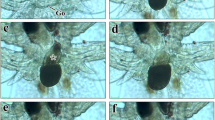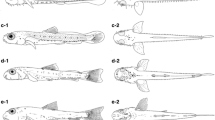Abstract
The embryonic development and morphology of eggs and newly hatched larvae of the Pacific herring Clupea pallasii were described using laboratory-reared specimens originating from the Miyako Bay stock. The eggs were almost spherical in shape, 1.33–1.46 mm (mean: 1.38 mm) in diameter, and had a thick adherent chorion. They had a segmented pale yellow yolk, no oil globule, and a relatively wide perivitelline space. A subgerminal cavity was observed during the gastrula period, whereas the blastocoel did not appear. Mass hatching occurred by 271 h 45 min after fertilization, and the newly hatched larvae were 7.1–7.7 mm (mean: 7.5 mm) in total length with 53–56 myomeres at 9.6°C. The embryonic development of Pacific herring was substantially similar to that of zebrafish Danio rerio, American shad Alosa sapidissima, as well as Atlantic herring Clupea harengus, and generally followed the basic developmental pattern of teleosts. However, Pacific herring larvae hatched at a more developed stage than some other clupeoids, such as Japanese sardine Sardinops melanostictus, and the progressed developmental stage at hatching could be interpreted as an advanced adaptation.

Similar content being viewed by others
References
Hay DE (1985) Reproductive biology of Pacific herring (Clupea harengus pallasi). Can J Fish Aquat Sci 42:111–126
Hanamura N (1963) A study on the method of prediction of the Hokkaido spring herring resources (in Japanese with English abstract). Bull Hokkaido Reg Fish Res Lab 26:1–66
Kobayashi T (2002) History of herring fishery in Hokkaido and the review of population study (in Japanese with English abstract). Sci Rep Hokkaido Fish Exp Stn 62:1–8
Pearson WH, Elston RA, Bienert RW, Drum AS, Antrim LD (1999) Why did the Prince William Sound, Alaska, Pacific herring (Clupea pallasi) fisheries collapse in 1993 and 1994? Review of hypotheses. Can J Fish Aquat Sci 56:711–737
Hershberger PK, Elder NE, Wittouck J, Stick K, Kocan RM (2005) Abnormalities in larvae from the once-largest Pacific herring population in Washington State result primarily from factors independent of spawning location. Trans Am Fish Soc 134:326–337
Sweetnam D (2008) Review of some California fisheries for 2007: coastal pelagic finfish, market squid, dungeness crab, California spiny lobster, highly migratory species, ocean salmon, groundfish, California halibut, hagfish, Pacific herring, and recreational. CalCOFI Rep 49:15–38
National Association for the Promotion of Productive Seas (2010) Annual statistics of seed production and release in 2008 (in Japanese). National Association for the Promotion of Productive Seas, Tokyo
Iizuka A (1966) Studies on the early life history of herring (Clupea pallasi C. et V.) in Akkeshi Bay and lake Akkeshi. Bull Hokkaido Reg Fish Res Lab 31:18–63
Chimura M, Watanabe Y, Okouchi H, Shirafuji N, Kawamura T (2009) Hatch-period-dependent early growth and survival of Pacific herring Clupea pallasii in Miyako Bay, Japan. J Fish Biol 74:604–620
Okouchi H, Chimura M (2001) Ecology and homing of artificially produced herring juveniles released in Miyako Bay (in Japanese). Kaiyo Monthly 33:252–258
Jones BC (1972) Effect of intertidal exposure on survival and embryonic development of Pacific herring spawn. J Fish Res Board Can 29:1119–1124
Griffin FJ, Pillai MC, Vines CA, Kaaria J, Hibbard-Robbins T, Yanagimachi R, Cherr GN (1998) Effects of salinity on sperm motility, fertilization, and development in the Pacific herring, Clupea pallasi. Biol Bull 194:25–35
Kuwatani Y, Shibuya S, Wakui T, Nakanishi T (1978) Study on the egg development and breeding of the herring juvenile. I. Effect of temperature on the egg development (in Japanese). In: Sasaoka H (ed) Report on the development of enhancement techniques and market-feasibility research of herring. Hokkaido National Fisheries Research Institute and Research Department, Fisheries Agency of Japan, Kushiro, pp 11–29
Ojaveer E (2006) On the external and parental effects in early development of herring (Clupea pallasi) at the NE Kamchatka. Fish Res 81:1–8
Griffin FJ, Smith EH, Vines CA, Cherr GN (2009) Impacts of suspended sediments on fertilization, embryonic development, and early larval life stages of the Pacific herring, Clupea pallasi. Biol Bull 216:175–187
Uchida K, Imai S, Mito S, Fujita S, Ueno M, Shojima Y, Senta T, Tahuku M, Dotu Y (1958) Studies on the egg, larvae and juvenile of Japanese fishes. Series I (in Japanese). Second Laboratory of Fisheries Biology, Fisheries Department, Faculty of Agriculture, Kyushu University, Fukuoka, Japan
Kobayashi T (1993) Biochemical analyses of genetic variability and divergence of populations in Pacific herring (in Japanese). Bull Nat Res Inst Far Seas Fish 30:1–77
Takahashi Y, Hirokawa J, Kumagai A (1984) Studies on the methods of egg-taking and incubation of Pacific herring, Clupea pallasi. Suisanzoushoku 31:167–172
Purcell JE, Grosse D, Grover JJ (1990) Mass abundances of abnormal Pacific herring larvae at a spawning ground in British-Columbia. Trans Am Fish Soc 119:463–469
Ojaveer E (1981) Influence of temperature, salinity, and reproductive mixing of Baltic herring groups on its embryonal development. Rapp P-v Réun Cons Int Explor Mer 178:409–415
Kimmel CB, Ballard WW, Kimmel SR, Ullmann B, Schilling TF (1995) Stages of embryonic-development of the zebrafish. Dev Dyn 203:253–310
Hill J, Johnston IA (1997) Photomicrographic atlas of Atlantic herring embryonic development. J Fish Biol 51:960–977
Shardo JD (1995) Comparative embryology of teleostean fishes. I. Development and staging of the American shad, Alosa sapidissima (Wilson, 1811). J Morphol 225:125–167
Mabee PM, Olmstead KL, Cubbage CC (2000) An experimental study of intraspecific variation, developmental timing, and heterochrony in fishes. Evolution 54:2091–2106
Johnston IA (1993) Temperature influences muscle differentiation and the relative timing of organogenesis in herring (Clupea harengus) larvae. Mar Biol 116:363–379
Beacham TD, Schweigert JF, MacConnachie C, Le KD, Flostrand L (2008) Use of microsatellites to determine population structure and migration of Pacific herring in British Columbia and adjacent regions. Trans Am Fish Sci 137:1795–1811
Sugaya T, Sato M, Yokoyama E, Nemoto Y, Fujita T, Okouchi H, Hamasaki K, Kitada S (2008) Population genetic structure and variability of Pacific herring Clupea pallasii in the stocking area along the Pacific coast of northern Japan. Fish Sci 74:579–588
Martin KL, Moravek CL, Flannery JA (2009) Embryonic staging series for the beach spawning, terrestrially incubating California grunion Leuresthes tenuis with comparisons to other Atherinomorpha. J Fish Biol 75:17–38
Mito S (1979) Fish egg (in Japanese). Mar Sci Mon 11:126–130
McGowan MF, Berry FH (1984) Clupeiformes: development and relationships. In: Moser HG, Richards WJ, Cohen DM, Fahay MP, Kendall AW, Richardson SL (eds) Ontogeny and systematics of fishes. Allen, Lawrence, pp 108–126
Jones PW, Martin FD, Hardy JD (1978) Development of fishes in the Mid-Atlantic Bight: an atlas of egg, larval, and juvenile stages, vol. 1: Acipenseridae through Ictaluridae. Fish and Wildlife Service, US Department of the Interior, Fort Collins
Takita T (1966) Egg development and larval stages of the small clupeoid fish, Harengula zunasi Bleeker and some informations about the spawning and nursery in Ariake Sound (in Japanese with English abstract). Bull Fac Fish Nagasaki Univ 21:171–179
Long WL, Ballard WW (2001) Normal embryonic stages of the longnose gar, Lepisosteus osseus. BMC Dev Biol 1:6
Ballard WW (1986) Stages and rates of normal development in the holostean fish, Amia calva. J Expl Zool 238:337–354
Price JW (1934) The embryology of the whitefish, Coregonus clupeaformis (Mitchill) part I. Early embryology. Ohio J Sci 34:287–305
Swarup H (1958) Stages in the development of the stickleback Gasterosteus aculeatus (L.). J Embryol Exp Morphol 6:373–383
Yamamoto K, Yamauchi K, Kasuga S (1975) On the development of the Japanese eel, Anguilla japonica (in Japanese with English abstract). Bull Jpn Soc Sci Fish 41:21–28
Finch E, Cruz C, Sloman KA, Kudoh T (2010) Heterochrony in the germ ring closure and tail bud formation in embryonic development of rainbow trout (Oncorhynchus mykiss). J Exp Zool (Mol Dev Evol) 314B:187–195
Arezo MJ, Pereiro L, Berois N (2005) Early development in the annual fish Cynolebias viarius. J Fish Biol 66:1357–1370
Collazo A, Bolker JA, Keller R (1994) A phylogenetic perspective on teleost gastrulation. Am Nat 144:133–152
Acknowledgments
We are sincerely grateful to the members of the Miyako Station, National Center for Stock Enhancement (the former Japan Sea Farming Association) of the Fisheries Research Agency, for helping with the rearing experiments and providing valuable information. Thanks are also due to Y. Nagakura of the Miyako Station, National Center for Stock Enhancement, for providing salinity data in Miyako Bay. We also thank M. J. Miller for assistance with this manuscript. This study was partly supported by a grant-in-aid for creative scientific research, no. 12NP0201 (DOBIS), from the Ministry of Education, Science and Culture of Japan. T.K. was supported by Research Fellowships from the Japan Society for the Promotion of Science for Young Scientists. K.T. was partly supported by the Research Foundation from Toyo Suisan and the Eel Research Foundation Nobori-kai.
Author information
Authors and Affiliations
Corresponding author
Rights and permissions
About this article
Cite this article
Kawakami, T., Okouchi, H., Aritaki, M. et al. Embryonic development and morphology of eggs and newly hatched larvae of Pacific herring Clupea pallasii . Fish Sci 77, 183–190 (2011). https://doi.org/10.1007/s12562-010-0317-4
Received:
Accepted:
Published:
Issue Date:
DOI: https://doi.org/10.1007/s12562-010-0317-4




